Docker & Kubernetes 3 : minikube Django with Redis and Celery
Continued from the previous Kubernetes minikube (Docker & Kubernetes 2 : minikube Django with Postgres - persistent volume), we'll use Django with additional apps such as Redis and Celery.
Kubernetes version info:
$ kubectl version
Client Version: version.Info{Major:"1", Minor:"11", GitVersion:"v1.11.3", GitCommit:"a4529464e4629c21224b3d52edfe0ea91b072862", GitTreeState:"clean", BuildDate:"2018-09-10T11:44:36Z", GoVersion:"go1.11", Compiler:"gc", Platform:"darwin/amd64"}
Server Version: version.Info{Major:"1", Minor:"10", GitVersion:"v1.10.0", GitCommit:"fc32d2f3698e36b93322a3465f63a14e9f0eaead", GitTreeState:"clean", BuildDate:"2018-03-26T16:44:10Z", GoVersion:"go1.9.3", Compiler:"gc", Platform:"linux/amd64"}
We need to switch Python 3.6 because the Celery's "async" does not supported on 3.7.
We'll use Redis as a broker over other message brokers such as RabbitMQ, ActiveMQ or Kafka.
We'll also use Celery, an asynchronous task queue based on distributed message passing while the Redis as the message broker. Celery is task queue for a real time processing based on the producer consumer design pattern.
A producer creates the task. The task is placed in a messaging queue. Consumers subscribed to the messaging queue can receive the messages and process the tasks in a different queue.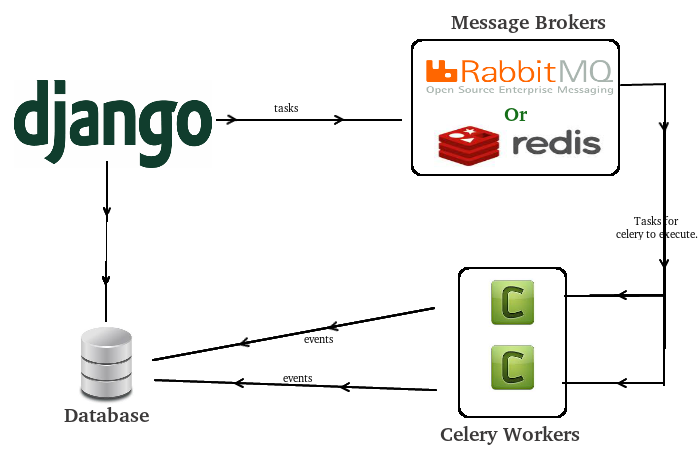
Picture from Python - Django
To integrate Celery with Django, create a __init__.py in the project root directory. Then another Python file celery.py in our kube_django app directory:
os.environ.setdefault('DJANGO_SETTINGS_MODULE', 'kube_django.settings')
app = Celery('kube_django')
...
app.autodiscover_tasks()
We define the environment variable DJANGO_SETTINGS_MODULE and the line, autodiscover_tasks() will run through all our modules and look for asynchronous task registered Django app configs.
from __future__ import absolute_import, unicode_literals from .celery import app as celery_app __all__ = ['celery_app']
After adding these codes, add the following variable into our main kube_django/settings.py:
# REDIS
REDIS_URL = "redis://{host}:{port}/1".format(
host=os.getenv('REDIS_HOST', 'localhost'),
port=os.getenv('REDIS_PORT', '6379')
)
CACHES = {
"default": {
"BACKEND": "django_redis.cache.RedisCache",
"LOCATION": REDIS_URL,
"OPTIONS": {
"CLIENT_CLASS": "django_redis.client.DefaultClient"
},
"KEY_PREFIX": "example"
}
}
# CELERY
BROKER_URL = REDIS_URL
CELERY_BROKER_URL = REDIS_URL
This would define the host of our Redis instance. Celery will look for variables with ‘CELERY_’ prefix in the settings.py defined in system environment.
Now, all our integration is done but definition of async tasks. To define an async task, simply import and add the decorator @shared_task to each method or function.
# Python
from datetime import datetime
# Celery
from celery import shared_task
@shared_task
def display_time():
print("The time is %s :" % str(datetime.now()))
return True
To spawn workers, we use the following command in deploy/celery/worker.yaml:
spec:
containers:
- name: celery-worker
image: dockerbogo/django_minikube:3.0.6
command: ['celery', '-A', 'kube_django', 'worker', '-l', 'info']
To have a celery cron job running, we need to start celery with the celery beat command:
spec:
containers:
- name: celery-worker
image: dockerbogo/django_minikube:3.0.6
command: ['celery', '-A', 'kube_django', 'worker', '-l', 'info']
To test if our Django app works with local virtual environment. Start the Postgres:
$ pg_ctl -D /usr/local/var/postgres start ... ...listening on IPv4 address "127.0.0.1", port 5432 ...listening on Unix socket "/tmp/.s.PGSQL.5432" done server started $ postgres -V postgres (PostgreSQL) 10.5
May need to install redis as well and run it:
$ brew install redis $ redis-server $ redis-client ping Pong
Virtualenv:
$ virtualenv venv $ source venv/bin/activate (venv) $ pip install -r requirements.txt (venv) $ python manage.py makemigrations (venv) $ python manage.py migrate Operations to perform: Apply all migrations: admin, auth, contenttypes, db, sessions Running migrations: No migrations to apply.
Now we can test if our app is working with database by starting up the Django development server:
(venv) $ python manage.py runserver 0.0.0.0:8000 Django version 2.1, using settings 'kube_django.settings' Starting development server at http://0.0.0.0:8000/ Quit the server with CONTROL-C.
In the web browser, visit the server's domain name or IP address followed by :8000 to reach default Django root page:
http://server_domain_or_IP:8000
We should see the following pages:
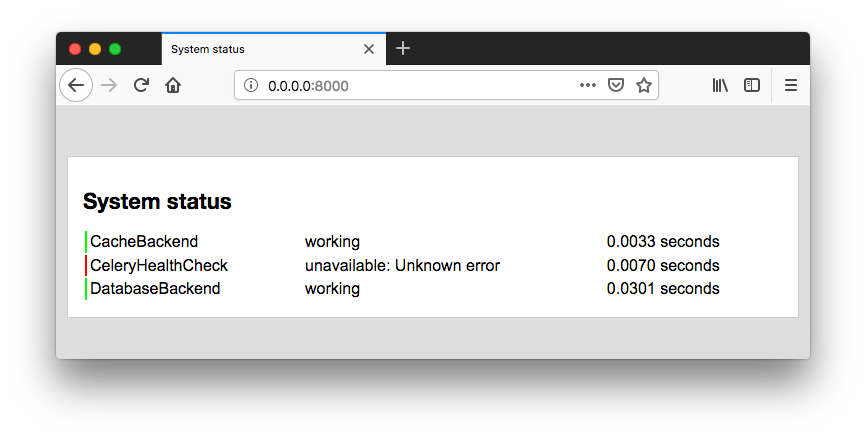
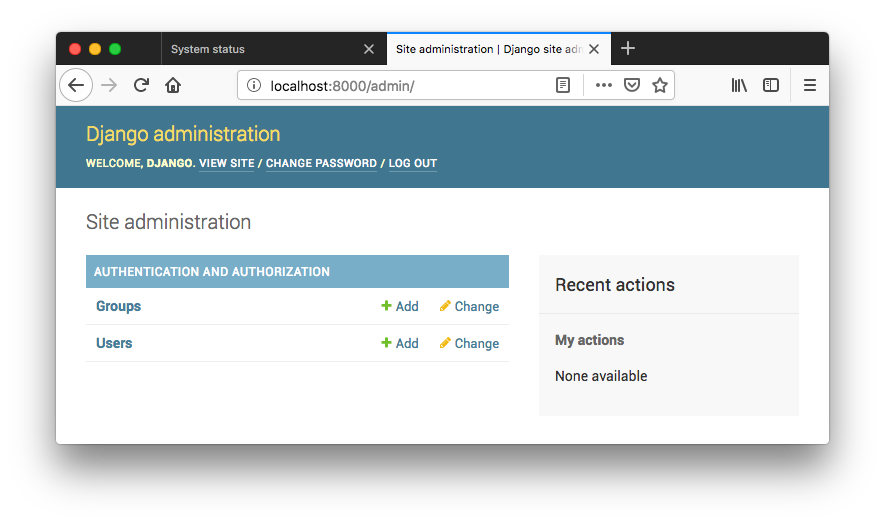
We can see our Django app is workings. So, exit from virtualenv and move on to minikube:
(venv) $ deactivate
$ minikube start $ kubectl config current-context minikube $ eval $(minikube docker-env)
Before building an image, remove "venv" if created.
Let's create the image and push it to DockerHub:
$ docker build -t dockerbogo/django-minikube-c:2.0.0 . $ docker push dockerbogo/django-minikube-c:2.0.0
Two ways of updating resources:
- We may want to delete any objects we created earlier and create new ones:
- Or we can just use kubectl apply our configurations to create resources:
$ kubectl delete -f deploy/postgres/ $ kubectl delete -f deploy/redis/ $ kubectl delete -f deploy/django/ $ kubectl delete -f deploy/celery/ $ kubectl create -f deploy/postgres/ $ kubectl create -f deploy/redis/ $ kubectl create -f deploy/django/ $ kubectl create -f deploy/celery/
$ kubectl apply -f deploy/postgres/ $ kubectl apply -f deploy/redis/ $ kubectl apply -f deploy/django/ $ kubectl apply -f deploy/celery/
To view the resources on our local cluster, we need to open up the minikube dashboard:
$ minikube dashboard






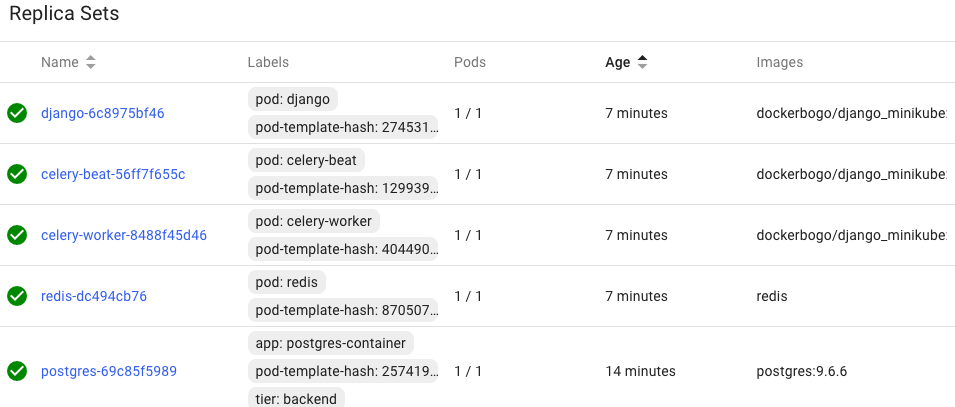
We can get the same info using kubectl:
$ kubectl get pods NAME READY STATUS RESTARTS AGE celery-beat-7c67bb87b8-p5vcj 1/1 Running 0 1h celery-worker-7f4554cbd5-vtxv5 1/1 Running 0 1h django-6c6b4c979f-lzxg8 1/1 Running 0 1h django-migrations-fzdsj 0/1 Completed 0 1h postgres-69c85f5989-fwmkz 1/1 Running 0 1h redis-dc494cb76-r88dz 1/1 Running 0 1h $ kubectl get services NAME TYPE CLUSTER-IP EXTERNAL-IP PORT(S) AGE django-service NodePort 10.99.185.28 <pending> 8000:30236/TCP 50m kubernetes ClusterIP 10.96.0.1 <none> 443/TCP 4h postgres-service ClusterIP 10.105.67.218 <none> 5432/TCP 50m redis-service ClusterIP 10.101.60.2 <none> 6379/TCP 50m
For debugging, we can use:
$ kubectl describe pod celery-beat-559b598c74-fn6sp $ kubectl logs celery-beat-559b598c74-fn6sp
$ minikube service django-service --url http://192.168.99.100:32289
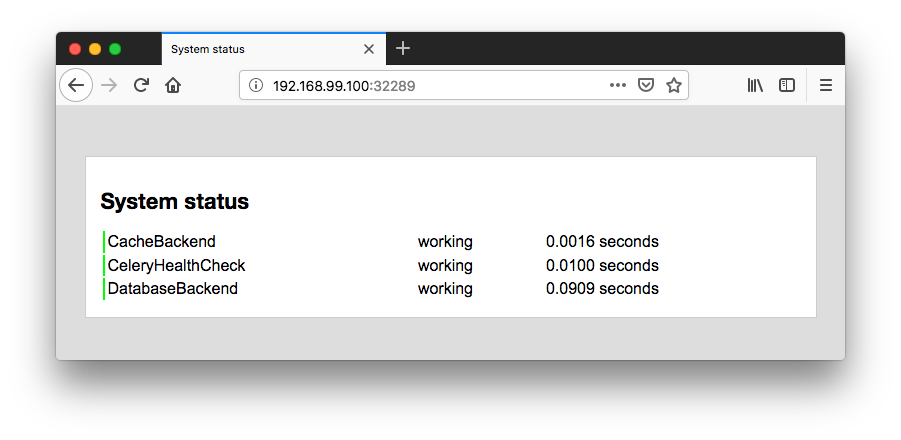
Source files - kubernetes_django/minikube-3/
Kubernetes, Local to Production with Django: 4 - Celery with Redis and Flower
Asynchronous Tasks with Celery + Redis in Django
Docker & K8s
- Docker install on Amazon Linux AMI
- Docker install on EC2 Ubuntu 14.04
- Docker container vs Virtual Machine
- Docker install on Ubuntu 14.04
- Docker Hello World Application
- Nginx image - share/copy files, Dockerfile
- Working with Docker images : brief introduction
- Docker image and container via docker commands (search, pull, run, ps, restart, attach, and rm)
- More on docker run command (docker run -it, docker run --rm, etc.)
- Docker Networks - Bridge Driver Network
- Docker Persistent Storage
- File sharing between host and container (docker run -d -p -v)
- Linking containers and volume for datastore
- Dockerfile - Build Docker images automatically I - FROM, MAINTAINER, and build context
- Dockerfile - Build Docker images automatically II - revisiting FROM, MAINTAINER, build context, and caching
- Dockerfile - Build Docker images automatically III - RUN
- Dockerfile - Build Docker images automatically IV - CMD
- Dockerfile - Build Docker images automatically V - WORKDIR, ENV, ADD, and ENTRYPOINT
- Docker - Apache Tomcat
- Docker - NodeJS
- Docker - NodeJS with hostname
- Docker Compose - NodeJS with MongoDB
- Docker - Prometheus and Grafana with Docker-compose
- Docker - StatsD/Graphite/Grafana
- Docker - Deploying a Java EE JBoss/WildFly Application on AWS Elastic Beanstalk Using Docker Containers
- Docker : NodeJS with GCP Kubernetes Engine
- Docker : Jenkins Multibranch Pipeline with Jenkinsfile and Github
- Docker : Jenkins Master and Slave
- Docker - ELK : ElasticSearch, Logstash, and Kibana
- Docker - ELK 7.6 : Elasticsearch on Centos 7
- Docker - ELK 7.6 : Filebeat on Centos 7
- Docker - ELK 7.6 : Logstash on Centos 7
- Docker - ELK 7.6 : Kibana on Centos 7
- Docker - ELK 7.6 : Elastic Stack with Docker Compose
- Docker - Deploy Elastic Cloud on Kubernetes (ECK) via Elasticsearch operator on minikube
- Docker - Deploy Elastic Stack via Helm on minikube
- Docker Compose - A gentle introduction with WordPress
- Docker Compose - MySQL
- MEAN Stack app on Docker containers : micro services
- MEAN Stack app on Docker containers : micro services via docker-compose
- Docker Compose - Hashicorp's Vault and Consul Part A (install vault, unsealing, static secrets, and policies)
- Docker Compose - Hashicorp's Vault and Consul Part B (EaaS, dynamic secrets, leases, and revocation)
- Docker Compose - Hashicorp's Vault and Consul Part C (Consul)
- Docker Compose with two containers - Flask REST API service container and an Apache server container
- Docker compose : Nginx reverse proxy with multiple containers
- Docker & Kubernetes : Envoy - Getting started
- Docker & Kubernetes : Envoy - Front Proxy
- Docker & Kubernetes : Ambassador - Envoy API Gateway on Kubernetes
- Docker Packer
- Docker Cheat Sheet
- Docker Q & A #1
- Kubernetes Q & A - Part I
- Kubernetes Q & A - Part II
- Docker - Run a React app in a docker
- Docker - Run a React app in a docker II (snapshot app with nginx)
- Docker - NodeJS and MySQL app with React in a docker
- Docker - Step by Step NodeJS and MySQL app with React - I
- Installing LAMP via puppet on Docker
- Docker install via Puppet
- Nginx Docker install via Ansible
- Apache Hadoop CDH 5.8 Install with QuickStarts Docker
- Docker - Deploying Flask app to ECS
- Docker Compose - Deploying WordPress to AWS
- Docker - WordPress Deploy to ECS with Docker-Compose (ECS-CLI EC2 type)
- Docker - WordPress Deploy to ECS with Docker-Compose (ECS-CLI Fargate type)
- Docker - ECS Fargate
- Docker - AWS ECS service discovery with Flask and Redis
- Docker & Kubernetes : minikube
- Docker & Kubernetes 2 : minikube Django with Postgres - persistent volume
- Docker & Kubernetes 3 : minikube Django with Redis and Celery
- Docker & Kubernetes 4 : Django with RDS via AWS Kops
- Docker & Kubernetes : Kops on AWS
- Docker & Kubernetes : Ingress controller on AWS with Kops
- Docker & Kubernetes : HashiCorp's Vault and Consul on minikube
- Docker & Kubernetes : HashiCorp's Vault and Consul - Auto-unseal using Transit Secrets Engine
- Docker & Kubernetes : Persistent Volumes & Persistent Volumes Claims - hostPath and annotations
- Docker & Kubernetes : Persistent Volumes - Dynamic volume provisioning
- Docker & Kubernetes : DaemonSet
- Docker & Kubernetes : Secrets
- Docker & Kubernetes : kubectl command
- Docker & Kubernetes : Assign a Kubernetes Pod to a particular node in a Kubernetes cluster
- Docker & Kubernetes : Configure a Pod to Use a ConfigMap
- AWS : EKS (Elastic Container Service for Kubernetes)
- Docker & Kubernetes : Run a React app in a minikube
- Docker & Kubernetes : Minikube install on AWS EC2
- Docker & Kubernetes : Cassandra with a StatefulSet
- Docker & Kubernetes : Terraform and AWS EKS
- Docker & Kubernetes : Pods and Service definitions
- Docker & Kubernetes : Service IP and the Service Type
- Docker & Kubernetes : Kubernetes DNS with Pods and Services
- Docker & Kubernetes : Headless service and discovering pods
- Docker & Kubernetes : Scaling and Updating application
- Docker & Kubernetes : Horizontal pod autoscaler on minikubes
- Docker & Kubernetes : From a monolithic app to micro services on GCP Kubernetes
- Docker & Kubernetes : Rolling updates
- Docker & Kubernetes : Deployments to GKE (Rolling update, Canary and Blue-green deployments)
- Docker & Kubernetes : Slack Chat Bot with NodeJS on GCP Kubernetes
- Docker & Kubernetes : Continuous Delivery with Jenkins Multibranch Pipeline for Dev, Canary, and Production Environments on GCP Kubernetes
- Docker & Kubernetes : NodePort vs LoadBalancer vs Ingress
- Docker & Kubernetes : MongoDB / MongoExpress on Minikube
- Docker & Kubernetes : Load Testing with Locust on GCP Kubernetes
- Docker & Kubernetes : MongoDB with StatefulSets on GCP Kubernetes Engine
- Docker & Kubernetes : Nginx Ingress Controller on Minikube
- Docker & Kubernetes : Setting up Ingress with NGINX Controller on Minikube (Mac)
- Docker & Kubernetes : Nginx Ingress Controller for Dashboard service on Minikube
- Docker & Kubernetes : Nginx Ingress Controller on GCP Kubernetes
- Docker & Kubernetes : Kubernetes Ingress with AWS ALB Ingress Controller in EKS
- Docker & Kubernetes : Setting up a private cluster on GCP Kubernetes
- Docker & Kubernetes : Kubernetes Namespaces (default, kube-public, kube-system) and switching namespaces (kubens)
- Docker & Kubernetes : StatefulSets on minikube
- Docker & Kubernetes : RBAC
- Docker & Kubernetes Service Account, RBAC, and IAM
- Docker & Kubernetes - Kubernetes Service Account, RBAC, IAM with EKS ALB, Part 1
- Docker & Kubernetes : Helm Chart
- Docker & Kubernetes : My first Helm deploy
- Docker & Kubernetes : Readiness and Liveness Probes
- Docker & Kubernetes : Helm chart repository with Github pages
- Docker & Kubernetes : Deploying WordPress and MariaDB with Ingress to Minikube using Helm Chart
- Docker & Kubernetes : Deploying WordPress and MariaDB to AWS using Helm 2 Chart
- Docker & Kubernetes : Deploying WordPress and MariaDB to AWS using Helm 3 Chart
- Docker & Kubernetes : Helm Chart for Node/Express and MySQL with Ingress
- Docker & Kubernetes : Deploy Prometheus and Grafana using Helm and Prometheus Operator - Monitoring Kubernetes node resources out of the box
- Docker & Kubernetes : Deploy Prometheus and Grafana using kube-prometheus-stack Helm Chart
- Docker & Kubernetes : Istio (service mesh) sidecar proxy on GCP Kubernetes
- Docker & Kubernetes : Istio on EKS
- Docker & Kubernetes : Istio on Minikube with AWS EC2 for Bookinfo Application
- Docker & Kubernetes : Deploying .NET Core app to Kubernetes Engine and configuring its traffic managed by Istio (Part I)
- Docker & Kubernetes : Deploying .NET Core app to Kubernetes Engine and configuring its traffic managed by Istio (Part II - Prometheus, Grafana, pin a service, split traffic, and inject faults)
- Docker & Kubernetes : Helm Package Manager with MySQL on GCP Kubernetes Engine
- Docker & Kubernetes : Deploying Memcached on Kubernetes Engine
- Docker & Kubernetes : EKS Control Plane (API server) Metrics with Prometheus
- Docker & Kubernetes : Spinnaker on EKS with Halyard
- Docker & Kubernetes : Continuous Delivery Pipelines with Spinnaker and Kubernetes Engine
- Docker & Kubernetes : Multi-node Local Kubernetes cluster : Kubeadm-dind (docker-in-docker)
- Docker & Kubernetes : Multi-node Local Kubernetes cluster : Kubeadm-kind (k8s-in-docker)
- Docker & Kubernetes : nodeSelector, nodeAffinity, taints/tolerations, pod affinity and anti-affinity - Assigning Pods to Nodes
- Docker & Kubernetes : Jenkins-X on EKS
- Docker & Kubernetes : ArgoCD App of Apps with Heml on Kubernetes
- Docker & Kubernetes : ArgoCD on Kubernetes cluster
- Docker & Kubernetes : GitOps with ArgoCD for Continuous Delivery to Kubernetes clusters (minikube) - guestbook
Ph.D. / Golden Gate Ave, San Francisco / Seoul National Univ / Carnegie Mellon / UC Berkeley / DevOps / Deep Learning / Visualization